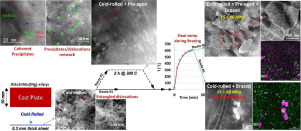当前位置:
X-MOL 学术
›
Acta Mater.
›
论文详情
Our official English website, www.x-mol.net, welcomes your feedback! (Note: you will need to create a separate account there.)
Precipitation-induced mitigation of recrystallization in ultra-thin, cold-rolled AlScZrMn(Mg) sheets at brazing temperatures: the critical effect of alloy composition and thermal processing route
Acta Materialia ( IF 9.4 ) Pub Date : 2020-03-01 , DOI: 10.1016/j.actamat.2020.01.003 Qingshan Dong , Andrew Howells , Mary F. Gallerneault , Vahid Fallah
Acta Materialia ( IF 9.4 ) Pub Date : 2020-03-01 , DOI: 10.1016/j.actamat.2020.01.003 Qingshan Dong , Andrew Howells , Mary F. Gallerneault , Vahid Fallah

|
Abstract Using advanced electron microscopy techniques, statistical analysis and analytical investigation of precipitates/dispersoids evolution, we demonstrate the critical effect of alloy composition (Sc, Mn, and Mg content) and thermal processing route (heating rate and pre-aging) on the recrystallization behavior of AlScZrMn(Mg) alloys. Two major types of second phases, namely Al3(Sc,Zr) precipitates and α-Al(Mn,Fe)Si dispersoids, were identified in the thermally-treated cold-rolled sheets (of 0.3 mm thickness). Both phases were observed to maintain coherency with the Al matrix at abnormally large sizes (>100 nm and >500 nm, respectively), as well as exhibiting unprecedented levels of thermal stability (i.e., high coarsening resistance). The recrystallization behavior and strength evolution were shown to be a strong function of the size and aerial number density evolution of the precipitates/dispersoids which, in turn, are controlled by the alloy composition and thermal history. Particularly, the recrystallization was effectively mitigated at a slow ramp to 590 °C (a typical brazing temperature for AlMn alloys) whereas a full recrystallization occurred during a faster ramp. Such behavior was explained by the competitive kinetics of Al3(Sc,Zr) precipitation and recrystallization phenomenon at intermediate and high-temperature ranges upon heating to 590 °C. The introduction of a pre-aging treatment within the intermediate temperature range (i.e., 250–400 °C), prior to the fast ramp, was shown to prevent recrystallization due to the stabilization effect of a large aerial number density of finely-dispersed Al3(Sc,Zr) precipitates. A higher Sc content in the alloy enhances such a stabilization effect. Mn additions not only enhance the mitigation of recrystallization (through a refinement of Al3(Sc,Zr) precipitates) but also refines the evolution of α-Al(Mn,Fe)Si dispersoids resulting in a higher yield strength. The Mg addition, on the other hand, has no impact on the evolution of Al3(Sc,Zr) precipitates nor on the recrystallization status, though it causes a refinement of α-Al(Mn,Fe)Si dispersoids and thus leads to a higher final yield strength. The extraordinary high-temperature stability of cold-rolled thin sheets, obtained by the alloy and process design in this study, can be effectively utilized for many light-weight applications of AA3xxx Al alloys.
中文翻译:

钎焊温度下超薄冷轧 AlScZrMn(Mg) 板中沉淀诱导的再结晶减缓:合金成分和热处理路线的关键影响
摘要 利用先进的电子显微镜技术、析出物/弥散体演化的统计分析和分析研究,我们证明了合金成分(Sc、Mn 和 Mg 含量)和热处理途径(加热速率和预时效)对再结晶的关键影响。 AlScZrMn(Mg) 合金的行为。在热处理的冷轧板(0.3 毫米厚)中发现了两种主要类型的第二相,即 Al3(Sc,Zr) 析出物和 α-Al(Mn,Fe)Si 弥散体。观察到这两种相都与异常大尺寸(分别为 >100 nm 和 >500 nm)的 Al 基体保持相干性,并表现出前所未有的热稳定性水平(即高抗粗化性)。再结晶行为和强度演变被证明是析出物/弥散体的尺寸和空间数密度演变的强函数,而这又受合金成分和热历史控制。特别是,在缓慢升温至 590 °C(AlMn 合金的典型钎焊温度)时,再结晶得到有效缓解,而在较快升温期间发生完全再结晶。这种行为可以通过加热到 590 °C 时在中高温范围内的 Al3(Sc,Zr) 沉淀和再结晶现象的竞争动力学来解释。在快速升温之前,在中间温度范围(即 250–400 °C)内引入预时效处理,由于细分散的 Al3(Sc,Zr) 析出物的大空气数密度的稳定作用,显示可防止再结晶。合金中较高的 Sc 含量增强了这种稳定效果。添加 Mn 不仅增强了再结晶的缓解(通过细化 Al3(Sc,Zr) 沉淀物),而且细化了 α-Al(Mn,Fe)Si 弥散体的演化,从而导致更高的屈服强度。另一方面,添加 Mg 对 Al3(Sc,Zr) 析出物的演化和再结晶状态没有影响,尽管它会导致 α-Al(Mn,Fe)Si 弥散体的细化,从而导致更高的最终屈服强度。通过本研究中的合金和工艺设计获得的冷轧薄板非凡的高温稳定性,
更新日期:2020-03-01
中文翻译:

钎焊温度下超薄冷轧 AlScZrMn(Mg) 板中沉淀诱导的再结晶减缓:合金成分和热处理路线的关键影响
摘要 利用先进的电子显微镜技术、析出物/弥散体演化的统计分析和分析研究,我们证明了合金成分(Sc、Mn 和 Mg 含量)和热处理途径(加热速率和预时效)对再结晶的关键影响。 AlScZrMn(Mg) 合金的行为。在热处理的冷轧板(0.3 毫米厚)中发现了两种主要类型的第二相,即 Al3(Sc,Zr) 析出物和 α-Al(Mn,Fe)Si 弥散体。观察到这两种相都与异常大尺寸(分别为 >100 nm 和 >500 nm)的 Al 基体保持相干性,并表现出前所未有的热稳定性水平(即高抗粗化性)。再结晶行为和强度演变被证明是析出物/弥散体的尺寸和空间数密度演变的强函数,而这又受合金成分和热历史控制。特别是,在缓慢升温至 590 °C(AlMn 合金的典型钎焊温度)时,再结晶得到有效缓解,而在较快升温期间发生完全再结晶。这种行为可以通过加热到 590 °C 时在中高温范围内的 Al3(Sc,Zr) 沉淀和再结晶现象的竞争动力学来解释。在快速升温之前,在中间温度范围(即 250–400 °C)内引入预时效处理,由于细分散的 Al3(Sc,Zr) 析出物的大空气数密度的稳定作用,显示可防止再结晶。合金中较高的 Sc 含量增强了这种稳定效果。添加 Mn 不仅增强了再结晶的缓解(通过细化 Al3(Sc,Zr) 沉淀物),而且细化了 α-Al(Mn,Fe)Si 弥散体的演化,从而导致更高的屈服强度。另一方面,添加 Mg 对 Al3(Sc,Zr) 析出物的演化和再结晶状态没有影响,尽管它会导致 α-Al(Mn,Fe)Si 弥散体的细化,从而导致更高的最终屈服强度。通过本研究中的合金和工艺设计获得的冷轧薄板非凡的高温稳定性,


























 京公网安备 11010802027423号
京公网安备 11010802027423号